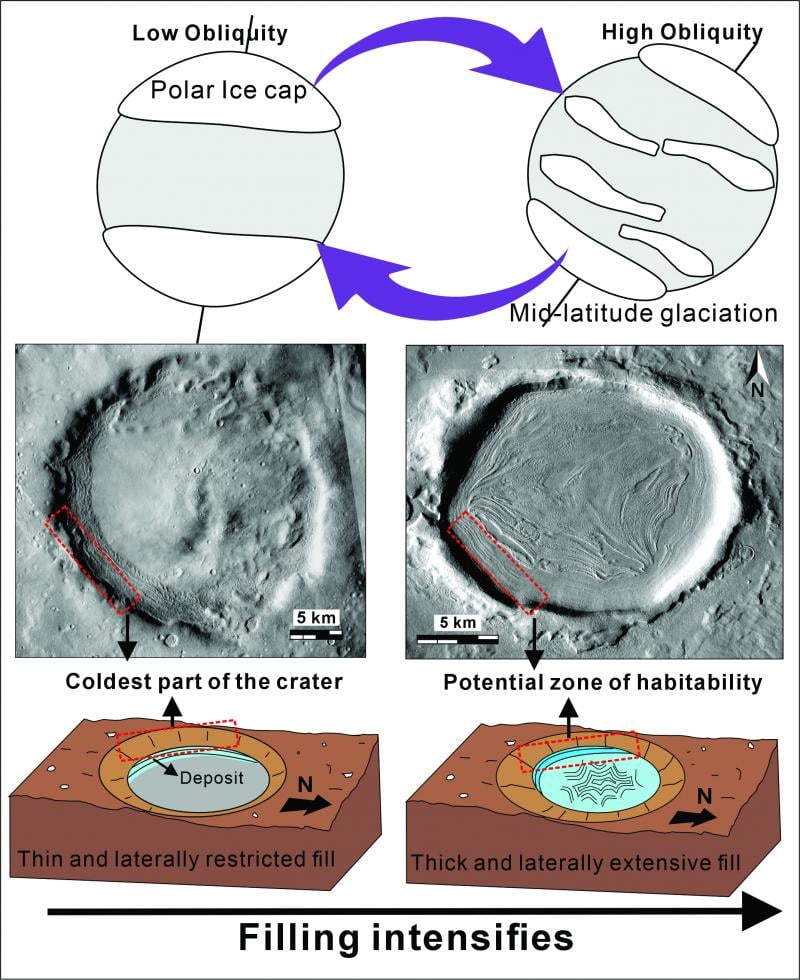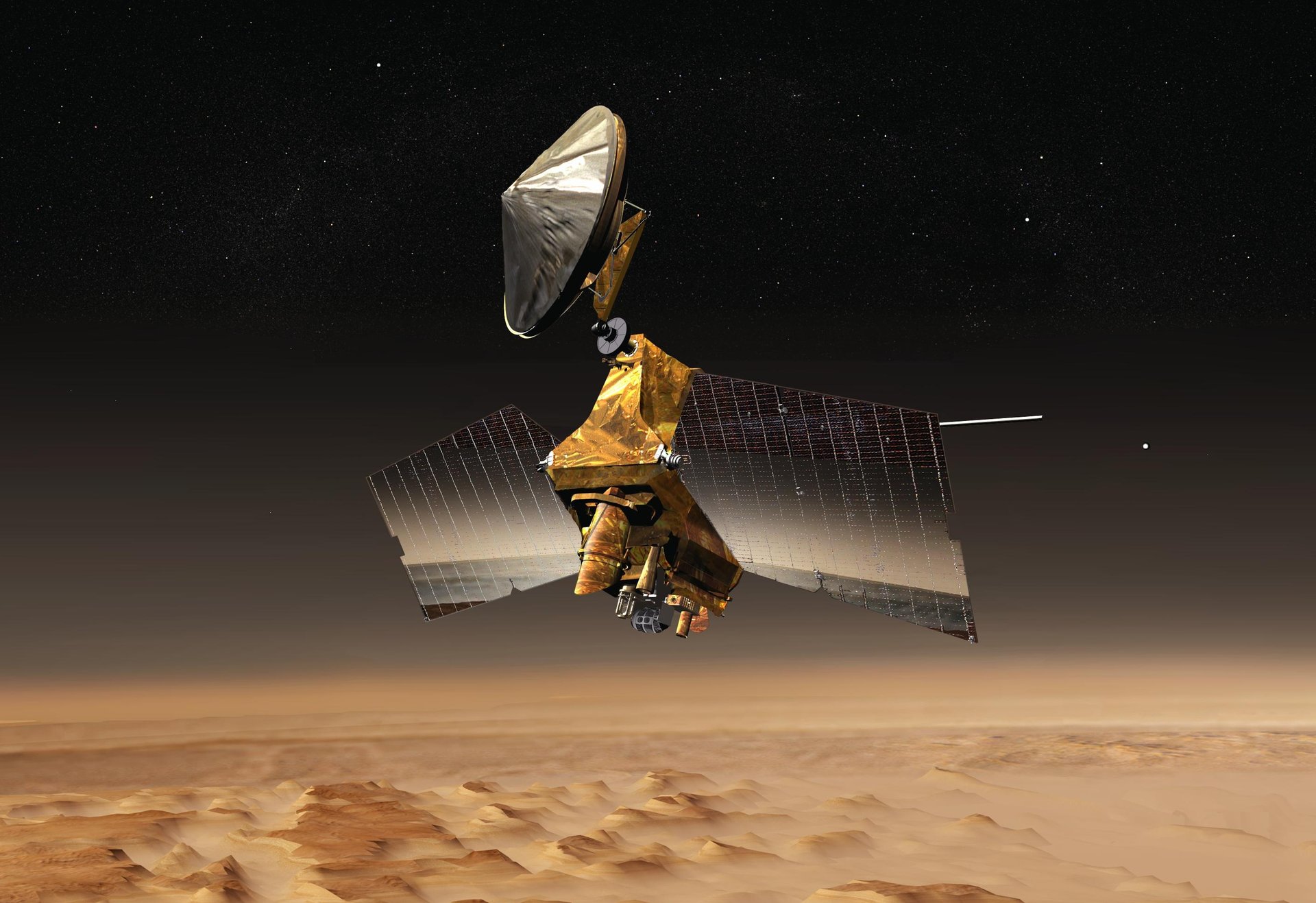On the surface of Mars, there are numerous features that tell of a past age when the planet was warmer and wetter, with rivers, lakes, and even an ocean that covered much of its northern hemisphere. These include river channels, delta fans, sedimentary deposits, and low-lying regions rich in clay minerals. The discovery and study of these features over the past fifty years have raised some pressing questions for scientists. These include the question of how much water once flowed on Mars and what led to the gradual transition that left the planet a frigid, desiccated world, where the only water on the surface comes in the form of ice and permafrost.
According to new research by a team of Japanese researchers, the answer may lie deep within Martian craters that contain deposits of water ice. Similar to how glaciers on Earth record cycles in the Earth's climate stretching back eons, these craters contain layers of ice that are essentially a record of the planet's past. According to their paper, which appeared in the journal Geology, these craters reveal that Mars experienced multiple ice ages over hundreds of millions of years. However, the amount of ice decreased steadily, indicating that Mars lost its water over the course of eons.
The research was led by Trishit Ruj, an associate professor from the Institute for Planetary Materials at Okayama University and the leader of its Planetary Geology and Surface Simulation Laboratory (PGSSL). He was joined by researchers from the Kochi Institute for Core Sample Research, the International Research School of Planetary Sciences, Kochi University, Brown University, the University of Tokyo, and the JAXA Institute of Space and Astronautical Science (ISAS).
 Changes in Mars’ axial tilt (obliquity) drive shifts between polar ice caps at low obliquity and widespread mid-latitude glaciation at high obliquity. Credit: Ruj, T. et al. (2025).
Changes in Mars’ axial tilt (obliquity) drive shifts between polar ice caps at low obliquity and widespread mid-latitude glaciation at high obliquity. Credit: Ruj, T. et al. (2025).
The team focused their study on the glacial landforms preserved in craters between 20°N and 45°N latitude using high-resolution images taken by the Context Camera (CTX) and the High-Resolution Imaging Science Experiment (HiRISE) aboard NASA's Mars Reconnaissance Orbiter (MRO). They further focused on craters that had all the indications of glaciation, like ridges, debris left behind by ice sheets, and maze-like pit formations and compared their shapes and orientations to climate models.
This revealed that the ice in these craters consistently clustered in the shadowed southerwestern walls. What's more, this was consistent over the course of multiple glacial periods throughout the Amazonian period (from ca. 640 to 98 million years ago). Said Dr. Ruj in an Okayama University press release:
Mars went through repeated ice ages, but the amount of ice deposited in craters steadily shrank over time. These icy ‘time capsules’ not only reveal how Mars lost its water but also mark places where future explorers might tap into hidden ice resources.
Like Earth, these shifts in Mars' climate were caused by changes in the planet's axial tilt (obliquity), which is similarly inclined as Earth's (about 25 degrees compared to Earth's 23.4 degree-tilt). Unlike Mars, Mars obliquity can change dramatically over the course of eons, triggering periods of glaciation and thaws that gradually left less ice with each cycle. These results demonstrate that Mars dried gradually throughout the Amazonian Era, the latest (and longest) geological period in Martian history.
The team's research could also act as a guide for future crewed missions that will need to rely on locally-sourced water ice to grow food, produce oxygen gas and drinking water, and fashion propellant. Given the distance between Earth and Mars and the fact that it takes spacecraft six to nine months to make a one-way transit (using conventional propulsion), in-situ resource utilization (ISRU) will be an absolute necessity. What's more, this study could also have applications here on Earth, where climate change is causing the ice caps and glaciers to shrink with every passing year.
 *Artist's impression of NASA's Mars Reconnaissance Orbiter (MRO) in the skies above Mars. Credit: NASA*
*Artist's impression of NASA's Mars Reconnaissance Orbiter (MRO) in the skies above Mars. Credit: NASA*
Globally, rising temperatures are leading to increased rates of drought, forest fires, soil erosion, and flooding, which is placing increased stress on diminishing supplies of fresh water. In this sense, the same imaging and modeling tools used to study how the Martian climate has evolved could help scientists monitor glaciers, permafrost, and hidden caches of water here on Earth. In addition to helping future generations of explorers live and thrive on another planet, these techniques could also assist people live in an increasingly changing environment here at home.
“Mars serves as a natural laboratory for understanding how ice behaves over vast timescales," said co-author Dr. Hasegawa from Kochi University, The insights we gain here can sharpen our understanding of climate processes on Earth as well."
Further Reading: Okayama University, Geology

